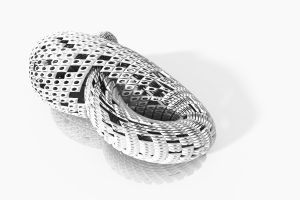This semester I decided to enroll in a Digital Design Course which was based on utilizing the computer program: Rhinoceros. Throughout the semester we learned about the different tools that Rhinoceros provides in the design process.
For our final project we were asked to incorporate the tools and skills we learned during the semester to create a pavilion that embodied a part-to-whole relationship.
The Klein Bottle Pavilion is a development from an investigation of the Klein bottle. The Klein bottle is a surface with no definable inner or outer surface. The pavilion not only physically embodies this attribute but also layers complexity by adding more continuous yet contrasting operations. A typical Klein Bottle consists of a narrow, neck-like portion which protrudes into a bulbous, larger volume; thisinherently creates a spatial condition of tension and release.
The continuous surface traverses its way through the pavilion, sculpting two distinct spaces. From the entry one moves into a slightly claustrophobic and ephemeral space which then culminates into a larger, relieving space of aggregation.
To further accentuate the effect of the Klein Bottle, the skin consists of modules that morph from a quadrilateral toan ellipse. This shape morph allows one to map and understand the Klein Bottle in a clear manner. It also provides avarying texture to the surface, enhancing the reading of the inner and outer.
Although the typical assembly of structure and enclosure distinguishes the two-instead the modular strategy utilizedin this pavilion furthers the concept of amalgamation by employing both structure and enclosure. Each module iscomposed of a rectangular steel plate, which is welded to one another, with an ABS plastic planel on either side.








Leave a comment
Comments feed for this article